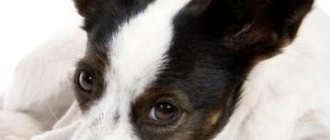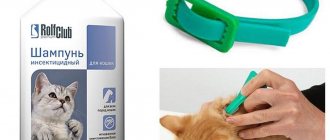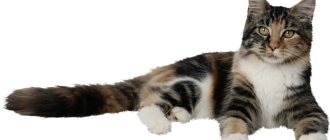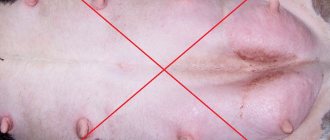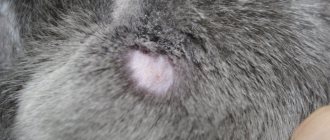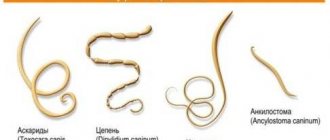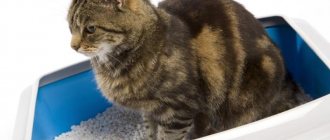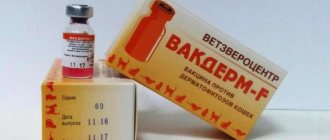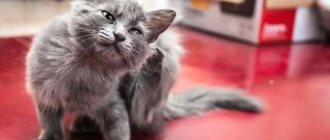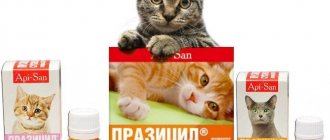Ringworm in cats is a fairly common fungal disease that is familiar to most owners of mustachioed pets. Moreover, it does not matter at all whether the animal has access to the street or lives exclusively at home - the risks of becoming infected are exactly the same.
Ringworm is a collective term for fungal infections caused by trichophytes, mainly Trichophyton and Microsporum (Trichophytes and Microspores). Other known names for lichen are microsporia, dermatophytosis and trichophytosis. The disease belongs to the category of zooanthroponoses, i.e. transmitted from animal to human.
The most susceptible are:
- kittens and young cats up to one year;
- adult cats with weak immune systems;
- long-haired cats.
How is ringworm transmitted?
Lichen fungi spread through spores that are visible only under a microscope. Transfer occurs through the air, settling on various surfaces and clothing. Cats can become infected even without having contact with a carrier of the spores, just by lying on the grass where another sick animal had previously rested or ran, or by rubbing against the owner’s clothes.
up to 3 months after infection , so symptoms of deprivation of a domestic cat do not appear immediately. In the initial stage, there may be no clinical symptoms at all, and the animal may outwardly appear clinically healthy. The intensity of symptoms depends on the level of infection and the state of the animal’s immune system.
Transmitted:
- people with weak immune systems;
- small children of preschool age.
In humans and animals with a strong immune system, the disease does not manifest itself. However, fungi on the skin can live for years in a suppressed state - a healthy, strong body will restrain the development of lichen.
How to distinguish from other types of lichen
Cats get sick not only from ringworm, the most common, but also from other types of lichen. All of them have characteristic manifestations:
- The pityriasis (multi-colored) form of the disease often occurs in cats with increased oily skin, as well as in animals living in hot climates. It develops due to the active reproduction of yeast fungi in the upper layers of the skin. It appears as spots of different shapes on the skin. Their color can be pink, yellow, brownish.
- Lichen planus develops when there is a malfunction in the immune system. On the surface of the cat’s skin and mucous membranes, areas appear covered with flat, smooth, red bubbles; they have a depression in the center. The disease is not contagious.
- Pityriasis rosea is viral in nature. At the beginning of the disease, one large, hairless, pink plaque (maternal) appears on the cat’s body. Later, many smaller lesions appear. They are very itchy and covered with scales. The disease is transmitted to other animals.
- Ringworm (eczema) is not contagious. It can be caused by an allergy or a bacterial agent. It begins with the appearance of redness and itchy blisters on the skin. Scratching causes them to burst, liquid comes out, and later pustules and crusts form.
Symptoms in a cat
Classic signs are:
- small bald patches with evenly rounded edges, manifested by itching;
- flaky crusts may form in areas of bald spots;
- bald patches are yellowish, reddish or grayish in color;
- in places where there are bald patches, the hair looks like broken hairs, which continue to break off, increasing the “bare” surface;
- most often the muzzle, crown of the head, ears, tail and limbs closer to the fingers are the first to be affected;
- change in the general appearance of the coat (clumps, greasy), its loss;
- if the claws are affected, their deformation occurs.
What “clipped” lichen looks like is probably known to every cat owner, if it is not an atypical or superficial form. In the atypical form of lichen, hairless lesions appear singly with sparse hairs in the middle. Outwardly, such lesions will resemble frequent scratches or abrasions that are not completely bald, which will complicate diagnosis. With the superficial form of trichophytosis (microsporia), hair hairs may not break off or break off in rare cases, which eliminates the possibility of noticing the disease in long-haired cats.
Given the fact that the size of bald patches is very variable (from small, barely noticeable spots to large affected areas), owners should be wary of any hairless areas on their pet. If any strange bald areas appear, a visit to the veterinarian is mandatory!
The development of the disease is observed only in animals with weak immunity. Most often, healthy cats have one or two bald spots and that’s it. With the slightest weakening of the immune system, lichen can affect significant areas of the pet’s body with the manifestation of:
- general oppression;
- anxiety from large itchy areas;
- loss of appetite;
- bloody scratches with the addition of a secondary microbial infection.
Diagnostics
If a fungal infection is suspected, the cat is brought to the veterinary clinic, as to treat lichen under the supervision of a specialist. First, the doctor conducts a diagnosis to rule out other skin diseases and determine the type of lichen. A clinical examination is not enough for this; 3 methods are usually used:
- Wood's fluorescent lamp examination. The affected areas turn green under the influence of rays, but the accuracy of this method is only 50%: not all types of fungus give off a fluorescent glow and vice versa - sometimes healthy areas can become colored due to medications and chemicals. An uninfected animal may also have spores on its fur that glow.
- Examination under a microscope. To do this, they take damaged hairs and scrapings from the surface of the lesion - fungal cells are sometimes found in them. The accuracy of this method is approximately 70%: if no traces of infection are found, this does not mean that it is absent.
- Mushroom cultivation. This is the most accurate method, but it takes about 3 weeks. Affected samples of animal skin are kept in a special nutrient medium, its changes are observed, and then the grown cultures are studied under a microscope.
At the same time, a blood and urine test is done to rule out other infections, viruses, and to find out the general state of health.
If you find lichen in a cat, how can you avoid infecting others?
Carrying out disinfection measures is mandatory (see in detail, if a domestic cat has lichen, how to prevent it from becoming infected to a person):
- They carry out vacuum (vacuum cleaner) and wet cleaning of the room with the addition of disinfectants, and treat cat care items (see all disinfectants for treatment).
- The treatment of a sick animal is carried out using gloves.
- It is advisable to boil clothes that have been in contact with a sick animal.
Can a cat die from shingles?
Whether a cat or kitten can die from lichen is another question that worries many pet owners. If the cat's owner does not contact the veterinarian in time, the risk of death in the animal increases. However, pets die not from the deprivation itself, but from the consequences that may appear after it. Therefore, it is important to visit a doctor as early as possible and undergo a comprehensive examination.
Can other animals become infected?
Some people are concerned about the question: can a healthy domestic cat that is in the same room with a sick one have lichen. The disease is transmitted through direct contact with a carrier of the infection, so a sick cat can transmit the disease to other animals, both cats and dogs. Therefore, during illness, it is recommended to limit your pet’s contact with healthy household members.
Note! It is best not to let her go outside until she has fully recovered.
Features of diagnosing trichophytosis (microsporia)
Usually the diagnosis can be made based on the classic clinical picture. However, given the similarity of ringworm to flea dermatitis, allergies and various forms of feline alopecia (hair loss), a final diagnosis is made only after a number of additional examination methods and only by a veterinary specialist.
Typically, 3 main tests are performed for an accurate diagnosis:
- Irradiation with an ultraviolet Wood lamp.
- Microscopy of cat fur.
- Sowing skin scrapings onto a fungal nutrient medium.
Using a Wood's lamp, you can identify the very initial signs of lichen. The lamp produces ultraviolet rays, under which the spores and the results of the life activity of many microspores begin to be illuminated with a light greenish light. This test is considered the most famous and most often used, but you need to know that:
- not all fungi give off a glow, but only in 60% of cases;
- the glow may be caused by certain medications applied by the owners to the affected area as treatment;
- iodine and brilliant green applied to the affected areas mask the glow, even when it potentially should be.
If the doctor is confused by the discrepancy between the presence or absence of luminescence and the clinical manifestation of the disease, auxiliary diagnostic methods are used to clarify the diagnosis.
To conduct microscopy of cat hair as informatively as possible, it is necessary to have a special mini-laboratory, a microscope with the required magnification, and sufficient experience from a veterinarian. Skin scrapings and a few hairs are examined under a microscope, where an abundance of tiny fungal spores can be seen.
Cultures on nutrient laboratory media are considered the most informative and most error-free way to diagnose fungal infections. However, they are used quite rarely due to the length of wait for results (on average, about 2.5-3 weeks). The scraping from the affected area is placed on a special nutrient medium, which provokes the accelerated growth of dermatophyte fungi. In addition to a general diagnosis, this method can accurately determine the specific causative agent of the disease. The most popular media are ascites agar and Sabouraud's medium with the addition of keratin hydrolyzate.
If at least one domestic cat has been diagnosed with trichophytosis (microsporia), then absolutely all pets in the house are subject to examination, even when at first glance they look absolutely healthy. Very often, the disease does not manifest itself clinically, but trichophytosis spores are found on the fur and skin, which spread everywhere. Spore-bearing animals are subject to mandatory treatment on the same basis as sick animals.
How to identify
The fastest and most reliable method to check for ringworm in a cat is to analyze material taken from the animal under an instrument such as a microscope. In order to use this method, the veterinarian needs to scrape out a piece of hair and skin from the affected area of the cat.
Remember that you need to take not only the infected cat, but also all pets, to the veterinarian for diagnosis, even if they do not have obvious symptoms of the disease. Often this disease affects everyone who has been in contact with the patient.
Actions of the owner upon detection of lichen in a pet
The very first and most reasonable thing an owner of a mustachioed pet can do is to immediately seek help from a veterinarian. Ringworm is a highly contagious fungal disease with a wide and rapid spread and possible infection of humans, so treatment of the animal, if the diagnosis is confirmed, must begin immediately.
The main actions of the owner of a sick cat:
- If possible, isolate the infected animal from people and other animals. If it is not possible to isolate, minimize contact with a sick animal and do not allow it on beds/chairs/sofas;
- check all domestic animals that have potential contact with an infected cat, apply treatment and preventive measures to all animals in the house;
- affected areas of skin are treated only with gloves;
- you should not abandon the treatment process without completing it;
- It is forbidden to bathe animals until recovery in order to prevent the spread of spores throughout the body (with medicated shampoos - an exception);
- reconsider the way of keeping a sick animal and feeding in order to improve conditions to increase immunity.
Is cat lichen dangerous for humans?
Veterinarians and dermatologists always give an affirmative answer to the question of whether a fungus is transmitted from a cat to a person. The disease is contagious. The incubation period for infection acquired from an animal is 5 to 7 days. But after contact with an infected cat, not everyone gets sick.
The fungus is dangerous for children, as well as weakened people with a low level of immune defense. Almost always people who get lichen are those who have fresh wounds on their skin during contact with animals.
Timely treatment of lichen allows you to get rid of it in 3-5 weeks. An advanced disease leads to bald spots on the head, suppuration, and later – scars on open areas of the skin.
Treatment with traditional methods
You can try to help your pet using traditional methods. However, it must be remembered that it is not always possible to cure ringworm with folk remedies, and the remedies themselves can pose a greater danger to the cat than many synthetic drugs from pharmaceuticals. Most often, folk treatment for ringworm in kittens is used, but you need to be careful with the selection of components and it is always better to consult a veterinarian.
- Baths with sulfurous lime. 1 tsp lime is diluted in a small basin of water and the animal is immersed in this water, thoroughly washing the affected areas. They take it out, wrap it in cloth, blot it and dry it, without allowing the animal to lick itself. Not suitable for small kittens. Side effects may include vomiting, allergies, and irritation.
- Soapy water (grate 10-15 g of laundry soap and dilute it in a liter of water) is used to soak and painlessly remove flaky crusts, applying to the affected areas with a cotton pad or swab, and not allowing licking. There are no side effects.
- Any wood ash is mixed 1:1 with butter or lard to a thick cream. Lubricate the affected areas generously. Bandages may be applied to prevent licking.
- Wash in carbolic soap. A good remedy for lichen in the initial stages, but the product is quite poisonous, there is a risk of poisoning if the hair is not completely rinsed after bathing. Do not use for washing kittens.
- Lubricate the affected areas with propolis tincture or iodine. The result is not always positive and there is a high probability of getting a chemical burn and irritation due to the individual sensitivity of cats to iodine and alcohol products
Symptoms of the disease
Ringworm manifests itself with the following symptoms:
- excessive hair loss;
- dryness and flaking of the skin;
- swelling on the skin, puffiness;
- the appearance of pigmentation on the body;
- severe itching.
Folk remedies for fleas in cats
As the disease progresses, the cat's mood also changes. They become slow and anxious, often begin to lick their fur and scratch problem areas.
Important! Symptoms appear almost immediately after the lesion. In some cases, the fungus can develop without clear negative signs.
Ringworm (eczema)
Eczema is characterized by red spots and severe itching. As the disease progresses, kittens develop abundant pigmentation, which is accompanied by increased temperature in the problem area. Over time, the rash turns into small blisters that burst, become wet and crust over. They cause severe itching, discomfort and contribute to the infection of the animal with bacterial diseases. Eczema may be accompanied by fever, malaise and drowsiness.
Pityriasis versicolor (variegated)
The pathology is presented in the form of a small pale spot that appears on the body of the animal in the early stages of development. As the disease progresses, the spot begins to grow and give negative symptoms: slight itching, peeling of the skin. The skin at the site of the lesion can be either smooth or scaly. Pityriasis versicolor is practically not reflected in the general condition of the cat; it can disappear without drug treatment and reappear.
Pityriasis versicolor in a kitten is the most harmless of the existing types of disease
Pityriasis rosea
The disease, which is devoid of pronounced symptoms, manifests itself in the form of the formation of many pink spots on the pet’s body, which in appearance resemble an allergic rash. As the pathology develops, the pigmented formations increase in size and begin to itch. Although some cats have lichen asymptomatically.
Note! Pityriasis rosea is dangerous because if not treated in a timely manner, it can develop into sepsis or trichophytosis. In such cases, symptoms of general intoxication of the body, enlarged lymph nodes, malaise and loss of appetite are observed.
Treatment is medicinal
The question of how to treat ringworm in cats medicinally can only be answered by a specialist. Treatments for ringworm are never the same for different animals, even if they live in the same house.
When prescribing a course of treatment, the veterinarian proceeds from:
- severity of the disease;
- the size of the affected areas on the body;
- the state of immunity of a particular individual.
Treatment should only be comprehensive – treatment should not be carried out with just one drug. This treatment regimen allows you to completely cure the animal and not drive trichophytosis (microsporia) into a chronic state.
- Vaccines - only at the initial stages it is possible to use some vaccines for the treatment and prevention of dermatomycosis in cats.
- If large areas are involved, the animal is prescribed antifungal agents - ointments, tablets, shampoos.
- For a generalized form (very widespread), it is recommended to use: shampoos and tablets or
- shampoos and ointments.
- in case of extensive lesions, various types of immunomodulators are necessarily prescribed to increase the body's defenses.
Antilichen drugs are available in 4 forms:
- Vaccine preparations for injection.
- Shampoos with antifungal action.
- Antifungal agents for topical use (ointments, gels).
- Antifungal agents for oral use (tablets).
Causes of ringworm
A cat becomes infected with ringworm when fungi from an infected animal enter its body. The greatest risk areas include :
- Persian cats;
- kittens whose age does not exceed one year;
- cats whose immunity has weakened due to poor nutrition;
- cats with free access to the street;
- an animal that is sick with another disease.
Ringworm is transmitted from infected cats to their owners. Signs of ringworm in humans are accompanied by damage to the hair areas on the head, as well as damage to the nails. Children are the most sensitive to this disease, so you need to be careful when playing with a cat so as not to treat children as well.
Vaccine injection preparations
Vakderm-FA therapeutic and prophylactic vaccine drug actively used for the treatment of dermatomycosis and dermatophytosis in cats (trichophytosis and microsporia).
|
Polivac class=”aligncenter” width=”485″ height=”345″[/img]Vaccine against microsporia and trichophytosis.
|
MicrodermVaccine for the prevention and treatment of trichophytoses and microsporia.
|
Injections for lichen
DermicocideInjectable antifungal drug, active against microsporia and trichophytosis.
|
Antifungal shampoos
Veterinary Formula ANTISEPTIC & ANTIFUNGALAntifungal and antimicrobial shampoo that relieves itching and eliminates the symptoms of fungal dermatitis.
|
DoctorDermatological shampoo for veterinary use for the treatment of infectious and fungal skin infections. Removes flaky skin fragments well.
|
Antifungal agents for topical use
Epacid-FAn effective mycofungicidal (antifungal) contact action agent.
|
FunginA remedy for the treatment of microsporia and trichophytoses.
|
Ointment "Yam"Ointment with fugicidal, acaricidal and keratolytic activity. Active against trichophytosis.
|
SanodermCream for the treatment of cat ringworm. It has antipruritic, antiallergic, antifungal and antimicrobial effects.
|
Mycostop ProVETAntifungal spray with a wide spectrum of antifungal and antimicrobial effects, including action on microspores and trichophytes.
|
Oral antifungals (tablets)
Griseofulvin (analogues: Gricin, Biogrizin, Fulcin, Grizon-250)A human antifungal that helps the immune system fight ringworm and is used in domestic cats.
|
Itraconazole (analogs: Irunin, Itrakon, Orungal, Orungamin)One of the most effective human drugs used for trichophytosis and microsporia in cats. In capsules or tablets.
|
Terbinafine (Exifin, Lamisil)Not a very effective drug in the treatment of trichophytosis, but often used to treat lichen in cats. The disadvantage is high doses, which are explained by the rapid half-life of the drug.
|
Ringworm is a fungal, contagious disease that spreads from animals to humans. Treatment is definitely necessary and the prescribed treatment must be started as soon as possible. You cannot push the cat’s condition to the point where it cannot be saved due to the development of a generalized form of trichophytosis (microsporia).
Author:
Grinchuk Ekaterina Andreevna veterinarian
Precautions for people
Ringworm can also be transmitted from sick pets to people. Those most susceptible to infection are those with problems with the immune system, as well as young children aged 2 to 6 years. To prevent the possibility of infection, you need to limit contact with the animal, and entrust treatment to a person with strong immunity. Also, for prevention, it is recommended to use disposable gloves and special masks when treating affected areas.
Vaccination against pathology must be carried out with gloves
Ringworm is a serious fungal disease that is accompanied by unpleasant symptoms. The disease has several varieties, and some of them lead to serious consequences. To avoid complications and transmission of the disease to healthy family members, you need to consult a doctor in a timely manner, undergo a comprehensive examination and use prescribed medications. After therapy, it is necessary to vaccinate pets against these diseases.

